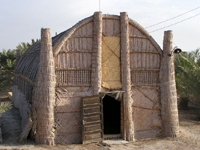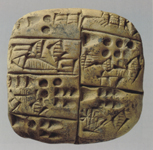Introduction to the Ancient Near East
Department of Egyptology and Ancient Western Asian Studies
Joukowsky Institute for Archaeology and the Ancient World
Brown University ~ Fall 2009




Meets Tuesdays and Thursdays 1:00-2:20 pm. in Rhode Island Hall 008 (60 George Street- On the Main Green)
A course with Ömür Harmanşah
Assistant Professor of Archaeology and Egyptology and Ancient Western Asian Studies
E-mail: [email protected]
Ömür's Office Hours: Wednesday 10-12 am. and Thursday 3-5 pm (By appointment)
Office: The new and gorgeous Rhode Island Hall Room 102.
Frequently Asked Questions (and their answers)
- Course Description: what is this course all about anyway?
- Course Requirements: what am I supposed to do???... Dates, deadlines, grading issues.
- Weekly Schedule: what is going on in class this week? what should I read?
- Weekly Readings: where do I download the readings? (password required)
- Assignments: what papers do I write for this class? how long should they be?
- Maps: where is this place called the Middle East?
- Resources: where do I find useful links to all kinds of nerdy crap (research databases, etc).
- Student Pages: How do I get represented on the world-wild-web, and increase my google ratings?
- Presentation topics: where are those presentation topics the professor is talking about?
- Powerpoints: those juicy powerpoints...
Course description
Where is Babylon? Where did the first cities of our old world emerge, the earliest writing on clay tablets was found? Whose stories were told in the epic of Gilgamesh? Who were buried with impressive objects of gold and lapis lazuli in the Royal Tombs of Ur? Where did the idea of building ziggurats come from, and who planted the Hanging Gardens of Babylon? In this course we will explore the cultures of ancient Mesopotamia and the Near East, mainly covering the modern day territories of Iraq, Syria, Turkey, and Iran. Reading literary and historical texts, working with archaeological evidence, inspecting data from environmental and climate research, and exploring visual and architectural cultures of Western Asia, we will investigate the rich history of this region.
This course offers an introduction to the study of the political, social and cultural history of the Ancient Near East, from prehistory to the end of the Iron age (ca. 330 BC). Both literary sources and archaeological evidence are examined as relevant. Near East is understood here in its widest geographic extent, including primarily the Mesopotamian lowlands, Iranian and Syro-Anatolian highlands, as well as the Levantine coast. The course not only offers a foundational survey of the historical developments in the region, but also addresses the broader methodological and historiographic problems involved in Near Eastern studies. State formation and the development of complex societies, cult practices and cuneiform literary traditions, art, architecture and material culture, issues of landscape and settlement systems, agricultural production, regional and interregional trade, and craft production will constitute the central issues in the course.
Read more...
Books ordered at Brown Bookstore
I'd go get these right away:
- Kuhrt, Amélie; 1995. The Ancient Near East: c. 3000-330 B.C. 2 Vols. Routledge: London and New York.
- Roaf, Michael; 1996. Cultural atlas of Mesopotamia and the Ancient Near East. Oxfordshire.
Really cool books if you are serious about it:
- Pollock, Susan; 1999. Ancient Mesopotamia: the Eden that never was. Cambridge University Press: Cambridge.
- Matthews, Roger; 2003. The archaeology of Mesopotamia: theories and approaches. London and New York: Routledge.
- Postgate, J. Nicholas; 1992. Early Mesopotamia: Society and Economy at the dawn of history. Routledge: London and New York.
- Akkermans, Peter M.M.G. and Glenn M. Schwartz; 2003. The archaeology of Syria: from complex hunter-gatherers to early urban societies (ca. 16,000-300 BC). Cambridge World Archaeology. Cambridge: Cambridge University Press.
Note: A copy of each of these books are also on reserve at the Rock (circulation desk).
Quick announcements
Midterm Take-home Essay Questions
Due: Monday Oct 19th, by 5 pm hard copy to Omur's mailbox at Joukowsky Institute.
